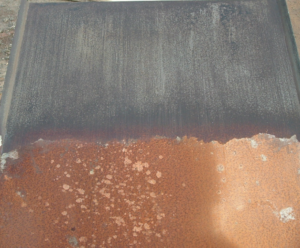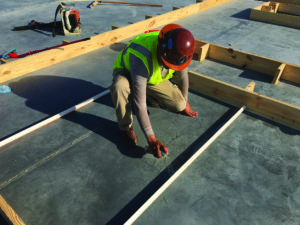It’s nearly April and if we can trust the old saying, we can assume April showers are on their way. What’s good for May flowers isn’t as good for steel forms. Steel forms are strong, reusable and can produce smooth, attractive concrete surfaces. But for all of their positive qualities, steel forms are not without their vices. Rust on steel forms is one of the primary problems. Rust is a chemical reaction that occurs when iron combines with oxygen and moisture. Water will increase the rusting process as will heat. Concrete produces heat as it hydrates, effectively creating an ideal environment for rust development.
Rusted forms produce stained, discolored concrete surfaces – an undesirable result. To avoid this, the forms need to be free from rust before the pour. So, how is existing rust removed from a steel form? Sanding is one method but needs to be done gently and with caution. Electric sanders and grinders can actually damage the surface of the forms and make rust more likely. Harsh chemicals can also lead to further problems, not to mention how they affect the safety and health of your workers.
Rust on forms is a problem and can be difficult to remove and prevent. But not to worry because Nox-Crete has the solutions.
Removing Existing Rust on Steel Forms
For existing rust on steel forms, our chemically active solution, Kem-Ex-It Plus won’t disappoint. This ready-to-use product breaks down and softens rust build up on your forms so that you can easily spray it away with a pressure washer. It not only removes rust scale from your steel forms, but also creates a protective barrier to prevent flash rust. Apply Kem-Ex-It Plus with the Nox-Crete Pump Foamer to create a thick foam that will cling to vertical and overhead surfaces, too. You can also use it to remove rust stains, salt deposits, and mortar splashings and lime water deposits from concrete and masonry surfaces. Plus, it’s effective in removing concrete buildup on steel and aluminum forms.

Before Kem-Ex-It Plus application.

Apply Kem-Ex-It Plus with a pump foamer for a rich foam.

Kem-Ex-It Plus offers effective rust removal.
Preventing Rust on Steel Forms
Once you’ve removed existing rust with Kem-Ex-It Plus, you’ll want to prevent future rust formation. For this, we recommend Formgard TJ Plus. This is a high performance rust inhibitor that chemically reacts instantly with surface moisture to form a waxy, protective coating that welds to the form surface both chemically and physically. It produces a highly water-resistant, polymerized film that provides rust protection from the corrosive effects of rain and salt water mist for up to six months of exposure to exterior conditions.
Use Formgard TJ Plus to prevent rust on:
- Steel utility molds
- Pre-stressed single and double tee beam forms
- Bridge girder forms
- Steel tunnel forms
- Steel waffle slab and dome pan forms

A portion of this bridge girder was treated with Formgard TJ Plus to prevent rust formation.
Just as Kem-Ex-It Plus has more than one use, Formgard TJ Plus does as well. This product doubles as a high performance precast concrete form release agent on molded fiberglass column forms, pan forms, waffle slab and dome forms. In precast applications, steel forms treated with Formgard TJ can be used immediately without removing applied product. The protective film won’t attract or hold dust.
Formgard TJ Plus is easy to apply with a hand pump sprayer, roller or brush and dries in approximately 30 minutes.
Clean up your rusted forms with Kem-Ex-It Plus and stay ahead of rust formation with Formgard TJ Plus
 chemical solutions to concrete problems
chemical solutions to concrete problems













